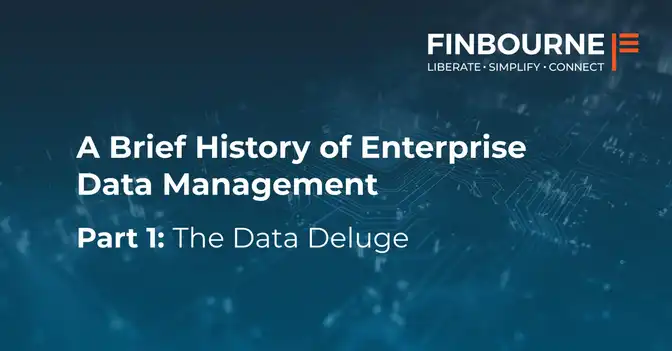Chris Brook, Co-founder and Head of Platform Engineering, FINBOURNE Technology
This article first appeared in Derivsource, September 29, 2021
There’s been a lot of talk about low-code, no-code, as the new tech trend to shake up buy-side operations. And while this is not a new phenomenon, recent market launches have renewed the buzz about its impact to the future of investment management software, unleashing with it an army of “citizen developers”. And while innovation adoption should always be encouraged, the truth is that the use-cases for low-code, no-code are in fact limited, and need to be balanced with the Buy Side’s need for flexibility and control.
Today, low-code, no-code technology already exists within several buy-side solutions and in varying forms. Take for example FINBOURNE’s LUSID platform and its ‘movements engine’. This can be viewed as an advanced example of a low-code solution, which enables asset managers to perform portfolio accounting with minimal transaction configuration required. Whilst this is not quite ‘drag and drop’, it is far simpler than getting your own engineering team to write a solution from scratch.
But the LUSID ‘movements engine’ is a very specific piece of technology, solving a very specific problem. Providers such as those offering EDM solutions, have a similarly specific problem to solve for their clients – e.g. getting access to market data – which make low-code/no-code solutions viable too. Where we take a more sceptical view is when claims are being made for more holistic use-cases, across the investment chain e.g. we can solve all your data management problems. This is unfortunately just science fiction.
Why? For the simple fact that investment management is a complex domain, spanning multiple service providers. If there are two things we hear regularly from conversations with prospective buy-side firms, it is how do we gain more flexibility and control over both our data and processes.
Some of this is down to the pitfalls of a multi-system landscape, which create inflexible processes and cause challenges, such as duplication, fragmentation and silos. This was echoed in a recently commissioned buy-side report from FINBOURNE, which found 73% of asset managers reported having at least moderate duplication issues, with multiple systems managing the same or similar functions within the business. While a further 77% of respondents had issues either with multiple silos across the business, multiple formats across systems or multiple vendors with interoperability challenge.
What does this mean for low-code, no-code?
The more complex the business process, the harder it is to automate and the harder it becomes to use a low-code, no-code approach. While no-code solutions may appear slick, with glossy drag and drop user interfaces, the reality is that there is still an inherent complexity which these tools attempt to hide. There is always some level of configuration required to drive the low/no-code ‘engine’, and at the end of the day, hiding that complexity introduces limitations. Users become constrained both in terms of what that solution can deliver, and its ability to cross boundaries between systems.
But what about the freedom low-code, no-code delivers? Freedom comes in many shapes and forms. Asset managers are striving to be liberated by the data that lives in their organisation, as opposed to be being limited by it because it’s either outdated, inaccurate or simply inaccessible. And whilst the investment chain is largely homogenous, no two asset managers are the same. Those specialisations and customisations will always require a more complex architecture and that simply requires more code.
The premise of citizen developers being given true freedom to develop as they please, is simply impractical for at least two reasons:
- With the current data drag affecting buy side firms, developers are already firefighting the massive backlog of data errors, even building in-house technology to tackle the complexities their colleagues face in reconciliation.
- When that’s not happening, there is the small matter of stringent operational governance, which exists to keep order and mitigate the very real risks to the wider (often fragile and interdependent) operational ecosystem. Even with the right guidelines and measures in place, the ability to write code creatively and freely would be difficult to realise. The perceived freedom and the reality are just not the same.
Low-code, no-code Vs Interoperability
The biggest operational constraint asset managers face today is aggregating and translating investment data from multiple systems and interfaces, into one standardised, language, to provide an accurate and real-time whole office view.
Low-code, no-code systems must be, by design, ‘opinionated’ about how they work. This is a prerequisite for turning a complex problem into a simple experience for users. Unless all the systems have the same opinions and definitions (for example, what constitutes a financial instrument), the ability to interoperate becomes impossible. Providers such as FINBOURNE are working to remedy this today, doing the hard integration work to create technical standards and well-defined APIs. This will provide a low-code route, to integrate different asset management technologies, giving firms the flexibility and niche, they desire.
If not low-code, no-code, then what? Solving this horizontal problem, requires true interoperability, including the use of open architecture and APIs. It requires technology that is far more advanced than legacy systems which are no longer fit for purpose, and even the broad but indistinct functionality that incumbent front-to-back systems provide.
What is needed is a new benchmark for accessing, understanding and controlling organisational data across the system landscape; delivered not only in true real-time but with a complete audit trail.
Stepping up the game with Bitemporal data
If we look at the data management complexities that exist in an organisation, they boil down to either delay and/or uncertainty. This is where we believe the value of bitemporal data really steps up the game. With bitemporal data, firms can easily rewind and access this data along across timelines. You see not only the effective date (e.g. when a trade actually happened) but also the as-at date: the date the trade was recorded in the system. Bitemporal data in this context means you can enter back-dated trades, or delete and re-book incorrect trades. By visualising the data bitemporally, you have clarity on what a portfolio holds, effective at any given point in history, as-at any point in history.
The above reconciliation example is just one of the many use-cases where bitemporal data can augment an investment process. There are also clear benefits across performance, risk and reporting, to business intelligence and distribution. Aside from investment functions, the impact to the business is manifold: liberating and empowering operational resources to move away from endless hours of manual effort and enabling buy-side firms to leverage the skills and talent available for high value (alpha generation) tasks.
To summarise, there is no reason that low-code, no-code cannot happily exist within buy-side operations, as long as firms fully understand the boundaries within which it can be applied. In the end, its interoperability and bitemporality; the ability to examine data across different points in time, that will provide a long-term solution to operational pain, and deliver the much-needed flexibility and control firms need to succeed.




